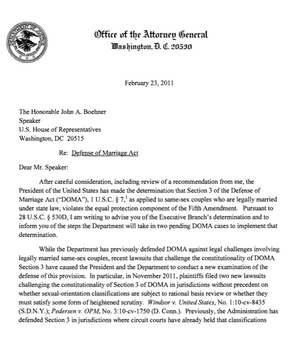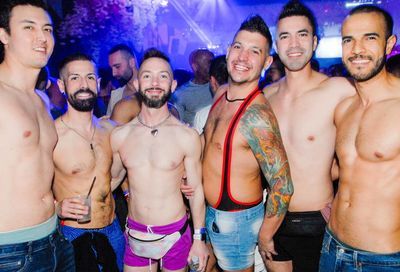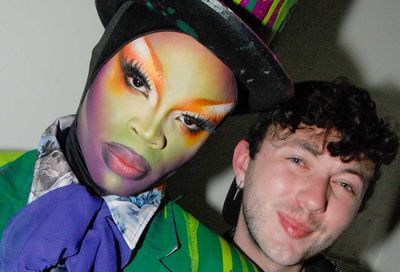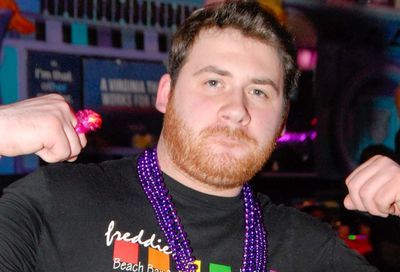Ninth Circuit Orders DOJ to Address Claim Regarding Lesbian’s Exclusion From Jury
Since mid-February, the government’s approach to laws or government practices that classify people based on their sexual orientation has changed significantly. The impact of that change is no more clear than is seen by the U.S. Court of Appeals for the Ninth Circuit’s response to a government brief — about jury selection — filed with the court on Feb. 17.
Under the Equal Protection Clause of the 14th Amendment — applied to the federal government through the Fifth Amendment — all laws that classify people into groups receive a level of scrutiny: rational basis, which is the lowest form of scrutiny; heightened scrutiny; or strict scrutiny.
The U.S. Supreme Court has not made a determination about the level of scrutiny to apply to sexual orientation classifications, even in the two cases in which it struck down anti-LGBT laws — Romer v. Evans and Lawrence v. Texas. On Feb. 23, though, Attorney General Eric Holder detailed in a six-page letter his and President Barack Obama’s determination that some level of heightened scrutiny should apply.
 Holder sent the letter to House Speaker John Boehner (R-Ohio), detailing his and the president’s decision — in two challenges to the federal definition of marriage contained in the Defense of Marriage Act — that heightened scrutiny should apply to classifications based on sexual orientation and that, under that heightened scrutiny, that portion of DOMA — Section 3 — should be found to be unconstitutional.
Holder sent the letter to House Speaker John Boehner (R-Ohio), detailing his and the president’s decision — in two challenges to the federal definition of marriage contained in the Defense of Marriage Act — that heightened scrutiny should apply to classifications based on sexual orientation and that, under that heightened scrutiny, that portion of DOMA — Section 3 — should be found to be unconstitutional.
The decision about heightened scrutiny quickly spread to other DOMA challenges; was cited by the lawyers seeking to have California’s Proposition 8 struck down as unconstitutional; was raised as the justification for including sexual orientation — and gender identity — in a DOJ investigation into New Orleans police practices; has impacted immigration cases; led to an unprecedented filing by the government on July 1 in a health benefits case brought by Karen Golinski; changed the DOJ’s policy for approaching married gay couples’ bankruptcy filings; and, most recently, was referenced by the Ninth Circuit in the ongoing appeal of the Log Cabin Republicans v. United States challenge to “Don’t Ask, Don’t Tell.”
Although broadly impacting a wide swath of cases involving LGBT people, the cases have been within the range of cases that have been a traditional part of LGBT organizations’ efforts at equality. In an order filed by the Ninth Circuit on the same day it lifted the stay on U.S. District Judge Virginia Phillips’s worldwide injunction halting enforcement of DADT, however, the court also issued an order questioning whether the Feb. 23 decision would have an impact on the government’s view about jury composition.
Questions about jury composition — more specifically, removal of potential jurors through what are called “peremptory challenges” — have been the subject of civil rights litigation in the past. The U.S. Supreme Court held in 1986 — in the case of Batson v. Kentucky — that a prosecutor could not use his peremptory challenges to remove potential jurors from cases based solely on their race. The ruling has since been extended to other classifications, including sex and national origin. A defendant who questions the removal of a potential juror as being based on a prohibited basis can make a “Batson motion” to challenge the prosecutor’s reason for removing the potential juror.
Daniel Osazuwa, who was charged with assaulting a prison guard, made a Batson motion after the government used a peremptory challenge to strike a lesbian juror — which led to the government’s response.
In a filing dated Feb. 15 (but that the Ninth Circuit states was filed on Feb. 17), the government opposed Osazuwa’s motion on several grounds. Among the reasons given, however, was one that “Binding Precedent Precludes Extending Batson to Sexual Orientation.”
Although several reasons were given why Batson should not be extended to include sexual orientation, the primary reason given in the brief signed by Assistant U.S. Attorney Mark R. Yohalem was that “[t]he Supreme Court has expressly held that ‘[p]arties may also exercise their peremptory challenges to remove from the venire any group or class of individuals normally subject to ‘rational basis’ review.” The government went on to argue that both the Ninth Circuit and Supreme Court “have held that rational basis review applies to classifications based on sexual orientation.” Under that precedent, the brief concluded, “defendant cannot assert a Batson claim based on sexual orientation.”
On July 6, looking at the changed landscape — and showing that even in the absence of action by attorneys, courts are noticing that new landscape — the Ninth Circuit issued an order restating the position argued by the government against Osazuwa’s Batson motion in February, noting the government’s July 1 filing in Golinski’s case and asking for an explanation of the difference.
The court order, signed by the clerk of the Ninth Circuit, stated:
In its answering brief in this case, filed on February 17, 2011, the Government argued that this court was bound by precedents holding that classifications on the basis of sexual orientation are subject only to rational-basis review under the Equal Protection Clause. On July 1, 2011, however, the Government filed a brief before the U.S. District Court for the Northern District of California, arguing that “heightened scrutiny, rather than rational basis review, is the appropriate standard of review for classifications based on sexual orientation.”
The court then ordered:
In light of this development, the Government is directed to file a supplemental brief of no longer than ten pages, addressing whether it adheres to the position that classifications on the basis of sexual orientation do not warrant heightened scrutiny under the Equal Protection Clause.
A response from the government — and a sign of the breadth of the impact of the Feb. 23 decision by Obama and Holder about heightened scrutiny’s application to sexual orientation classifications — is due by July 20.
READ:
- Government’s February brief: Dkt #26 USA’s Answering Brief.pdf
- Ninth Circuit order: U.S. v. Osazuwa Ninth Circuit Order 7-6-11.pdf
Support Metro Weekly’s Journalism
These are challenging times for news organizations. And yet it’s crucial we stay active and provide vital resources and information to both our local readers and the world. So won’t you please take a moment and consider supporting Metro Weekly with a membership? For as little as $5 a month, you can help ensure Metro Weekly magazine and MetroWeekly.com remain free, viable resources as we provide the best, most diverse, culturally-resonant LGBTQ coverage in both the D.C. region and around the world. Memberships come with exclusive perks and discounts, your own personal digital delivery of each week’s magazine (and an archive), access to our Member's Lounge when it launches this fall, and exclusive members-only items like Metro Weekly Membership Mugs and Tote Bags! Check out all our membership levels here and please join us today!




















